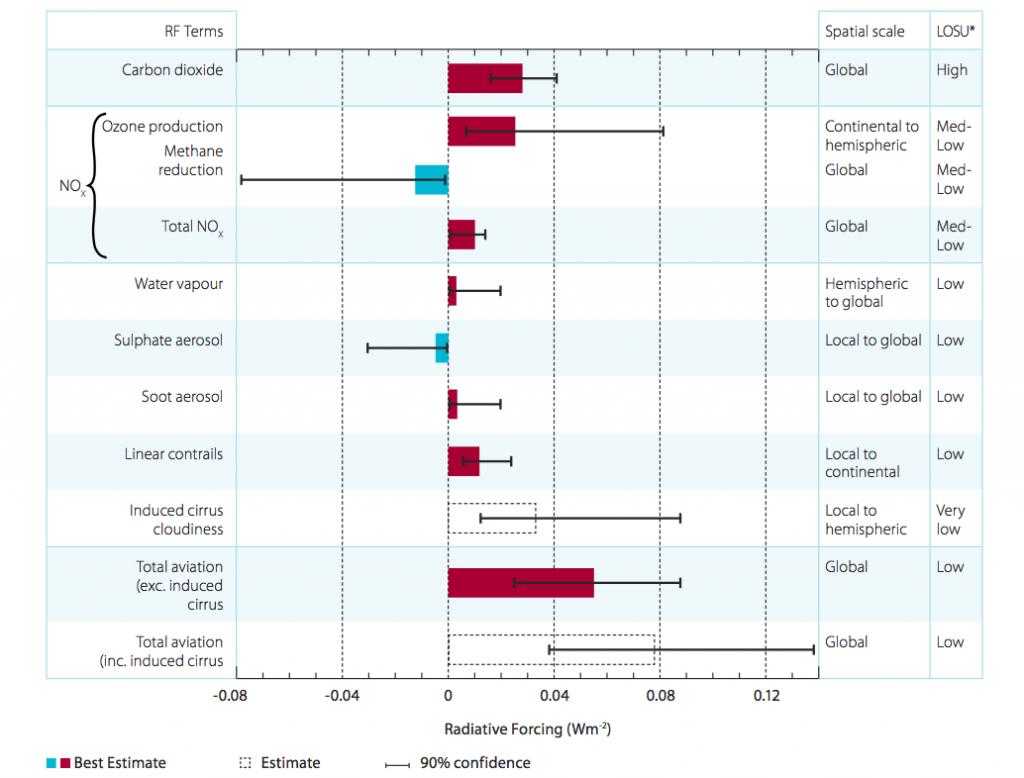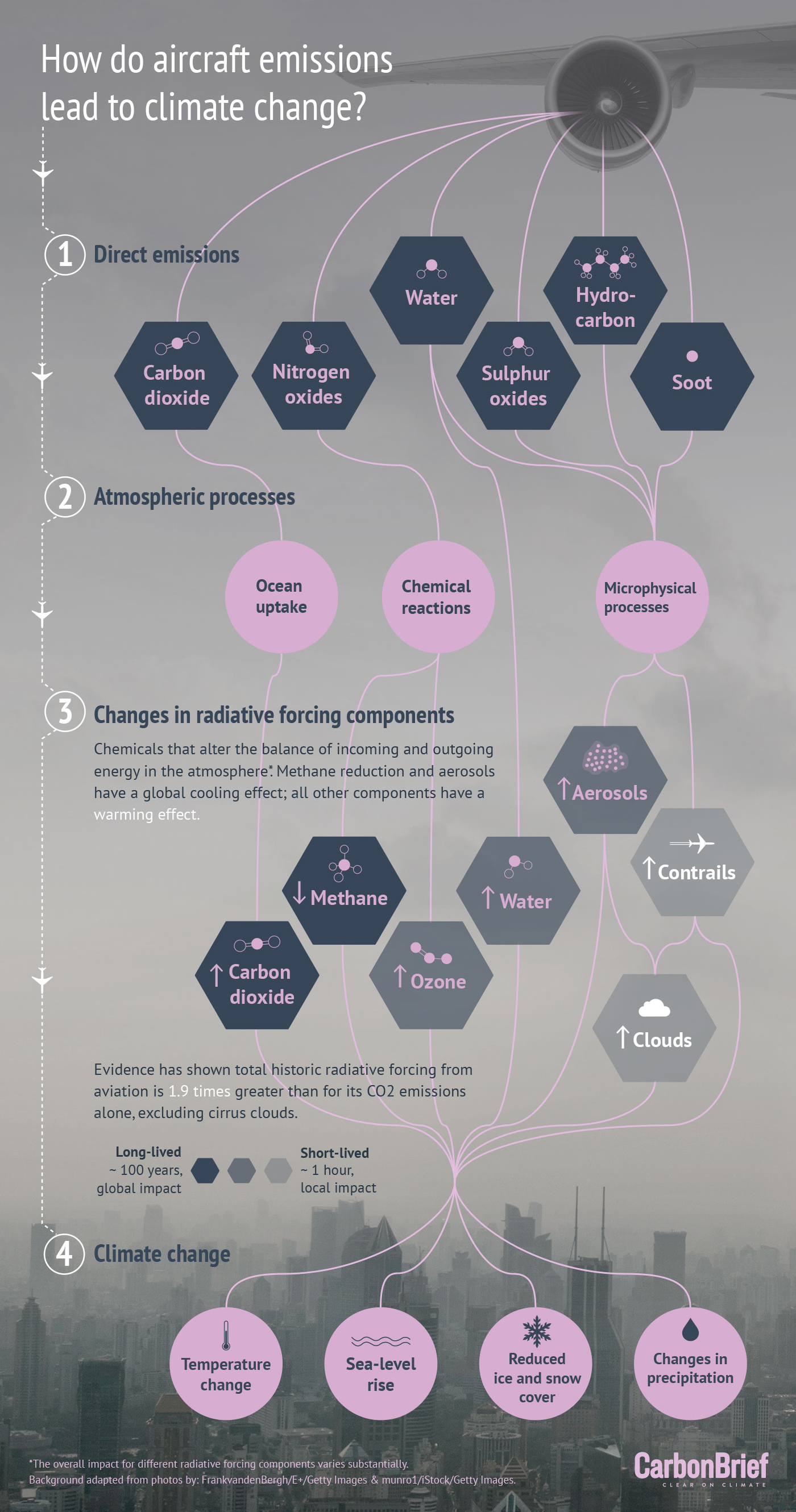
Explainer: The challenge of tackling aviation’s non-CO2 emissions
Jocelyn Timperley
03.15.17Jocelyn Timperley
15.03.2017 | 7:00amLast October, the 191 member states of the United Nation’s International Civil Aviation Organization (ICAO) agreed to a new deal to cap international aviation emissions using a carbon offset approach.
Despite relief from some quarters that this long-awaited deal – which aims to cap growth in aviation emissions at 2020 levels – had finally been achieved, there is still a long way to go before the problem of fast-rising aviation emissions is solved.
First, the offsetting nature of the ICAO scheme means countries still need to translate exactly how a deal – which doesn’t actually stop aircrafts emitting more CO2 and only begins in four years – will be able to align itself with the limits in global temperature rise set out in the Paris Agreement.
Second, there is another rather ominous hole in the efforts to tackle flight emissions which remains all but completely neglected.
The new ICAO deal only addresses CO2 emissions, ignoring other emissions from planes which research has shown could result in warming several times greater than for CO2 alone.
Carbon Brief takes a look at the impact of these non-CO2 emissions and examines new research setting out how they could be limited.
Non-CO2 emissions
Globally, aviation is responsible for around 2% of global anthropogenic CO2 emissions, but its impact is projected to rise by 200%-360% by 2050, even when the maximum use of lower-carbon alternative fuels is factored in.
This is a significant problem. For example, Carbon Brief analysis has shown the sector could claim as much as two-thirds of the UK’s carbon budget for 1.5C by 2050.
Significantly, these calculations don’t take into account the radiative forcing – the impact on the overall energy balance of the planet – caused by non-CO2 warming pollutants, such as water vapour, aerosols and nitrogen oxides.
The impacts of non-CO2 aircraft emissions at high altitudes came to prominence back in 1999 following publication of a special report by the International Panel on Climate Change (IPCC) on aviation. This estimated the total historic impact of aviation on the climate to have been two to four times higher than for CO2 emissions alone.
But while it has been well established for more than a decade that air traffic affects the climate through emissions other than just CO2, putting a number on the overall effect of these emissions has proven tricky.
In particular, the contribution of aircraft emissions to the formation of additional cirrus clouds – thin and wispy high-level clouds which can be formed by aircraft contrails – has proven extremely difficult to pin down. While it is known these clouds can trap thermal radiation – research has indicated their impact on global warming could dwarf that of CO2 from aviation – the mechanisms remaining poorly understood.

Estimates for radiative forcing from global aviation in 2005. The induced cloudiness (AIC) estimate includes linear contrails. Error bars represent the 90% likelihood range for each estimate. The level of scientific understanding (LOSU) is shown on the right. Source: CCC (2009), reproduced from Lee et al. (2009)
Most of the impact of these non-CO2 emissions comes from the “cruise phase” of a flight when the plane is at high altitudes. Importantly, though, this impact depends largely on atmospheric conditions, such as temperature and the background concentrations of water vapour and nitrogen oxides.
Contrails, for example, form when water vapour condenses on aerosol emissions. They are thought to have a significant warming effect. But, typically, they only last a few seconds in specific conditions of coldness and humidity.
Reducing impacts
In its 1999 special report on aviation, the IPCC set out four broad areas where greenhouse gas emissions could be reduced from flights: technological improvements, such as lightweighting; changes to (or replacements for) jet fuel; operational changes; and regulatory or economic options.
Even for CO2 alone there is a struggle to use these measures to limit aviation’s impact enough to meet targets without reducing the number of flights. But reducing the potentially larger non-CO2 warming impacts could be even more complex.
This is because the short atmospheric “lifetime” of many of these pollutants make their climate impact highly dependent on the location, season and time of day of emissions – unlike CO2 emissions, which spread out over the globe during their lifetime of centuries or more.
However, the short lifetime of non-CO2 emissions also means changes in operational procedures, such as air traffic management, could reduce their impact more than for CO2 emissions.

How do aircraft emissions lead to climate change? Infographic by Rosamund Pearce for Carbon Brief. Data from Brasseur et al (2009) and Lee et al (2009), and the IPCC.
For example, some researchers have argued that simply optimising flight routes to minimise the time spent in highly sensitive atmospheric areas could have a big impact. This could include changing the altitude or position of a flight to avoid colder pockets of air, especially at times of day or during seasons when the emissions will have the highest impact.
A Nature study published in 2006 found that night-time flying accounts for 60%-80% of all contrail forcing from planes, despite accounting for just a quarter of flights. This is because while contrails trap warming infrared energy during both day and night, this is offset somewhat during the day by a cooling effect as they reflect sunlight back into space.
The study also found winter flights have a far bigger overall warming effect than those taken during the rest of the year, since contrails are more likely to form when it is cold.
Therefore, adjusting the times and seasons when flights are taken could cut their non-CO2 impact significantly.
Another study, published in 2014, suggested lowering the altitude of aircrafts by around 2,000 feet (610 metres) could reduce the radiative forcing from emissions of nitrogen oxides (NOx) by two-fifths.
A further study published the same year found re-routing flights to avoid climatic regions which are particularly sensitive to the effects of non-CO2 emissions could lower their climate impact by a quarter, at a cost increase of just 0.5%.
Problem with rerouting
Altering flight trajectories to limit climate impacts presents some significant challenges.
For example, at a time when government policy and airspace regulators are already working to free up more airspace capacity, rerouting would instead create a new source of congestion.
The possibilities for designing altered routes could be hindered by air traffic service routes and national airspace boundaries. Procedures to ensure there is enough space between planes could also force planned climate-friendly trajectories to be changed. And there remain significant barriers to providing the required accuracy in predictions of wind, temperature and weather predictions.
Meanwhile, the new routes would have to be carefully balanced to ensure the resulting reduction in radiative forcing from non-CO2 emissions is not offset by the increased CO2 emissions of flying longer routes.
In addition, these longer routes would mean a bigger fuel cost for airlines, which currently don’t pay any penalty for their non-CO2 emissions.
New approaches
Nevertheless, work is ongoing to scope out ways in which non-CO2 impacts could be reduced.
A new paper released last month proposed an alternative form of flight rerouting using a regulatory approach to overcome some of the barriers.
Rather than optimising routes of individual aircrafts, it proposes restricting planes from flying in whole regions of airspace. The system would force aircraft to fly around regions where non-CO2 emissions would have a large impact on radiative forcing. The proposal would see a threshold value of climate costs set by policymakers, with airspaces which passed this value being closed until they had slipped below it again.
The paper argues this option, which could see airspaces closed for hours, days or even months in a situation akin to military restricted airspace, could be easily implemented by air traffic controllers and could be used as an interim solution to longer term proposals to cut non-CO2 emissions from air travel.
It finds the climate impact of flights could be cut by 12% at no extra cost to operators using such an approach. However, larger route changes could increase fuel costs and CO2 emissions, though still resulting in less forcing overall.
Malte Niklass, a researcher at the German Aerospace Center and lead author of the paper, says these so-called “climate restricted airspaces” would overcome the issue of aircraft operators often having little incentives to bear the additional costs of rerouting.
He adds that a similar market-based approach could create “climate charged airspaces”, where the highly climate sensitive regions are not fully cut off but levied with an environmental unit charge to encourage planes to fly around them.
However, responding to the paper, Cait Hewitt, deputy director of the Aviation Environment Federation (AEF), highlights the barriers that such a scheme would face, including the significant coordination of airspace management it would need among states – something she says has been surprisingly hard to achieve, even for more straightforward changes that would improve airspace efficiency. Such schemes could create a new source of congestion in lower airspace, she adds.
Meanwhile, settig a threshold for when a no-fly zone is switched on would need agreement from policymakers. For example, when should minimising non-CO2 emissions take precedence over minimising CO2 through more direct routing? “That’s unlikely to come any time soon,” she says.
Niklass himself admits there are significant challenges to such a scheme, including the ability to predict climate sensitive regions with a reasonable accuracy and the political decision on what the threshold should be. In the paper, he suggests the scheme could be applied to only the most ecologically harmful trajectories.
However, others argue there remains merit in researching ways to minimise non-CO2 emissions. Responding to the new paper, Tim Johnson, director of the AEF, says the scientific community should be “applauded for reminding us of the importance” of non-CO2 effects at a time when policymakers are focused solely on carbon emissions. He tells Carbon Brief:
“We need effective policies that tackle the total climate impact and not just CO2. These additional effects need to be included in our climate goals and accounting.”
A related paper published in the journal Environmental Research Letters (ERL) earlier this month found airlines could reduce their climate impact by up to 10% simply by making small changes to flight routes at a cost increase of just 1%.

Under certain atmospheric conditions, aviation can result in the formation of additional cirrus clouds which can increase warming. Credit: cmtyers/iStock/Getty images.
Keith Shine, professor of meteorology and climate science at the University of Reading and co-author of the new ERL paper, said, with more targeted research, such adjustment could become a reality in the next 10 years. “Climate-friendly routing of aircraft has an exciting potential to decrease the climate impact of aviation, without the need for costly redesign of aircraft, their engines, and airports,” he said.
Research into other ways of reducing non-CO2 impacts is also ongoing. For a paper published in Nature this week, for example, scientists used small, instrumented planes flying directly in the exhaust plume of jet plane to measure the emissions of various fuel mixes. Their results showed use of a 50/50 conventional fuel and biofuel blend could reduce aerosol emissions by 50%-70% compared conventional fuels alone.
Regulatory pipe-dream?
Despite this research, the prospect of policymakers tackling non-CO2 emissions any time soon remains slim, especially considering the difficulty in pinning down the precise magnitude of their impact. If anything, it seems to have slipped down the “to do” list since the 1999 IPCC report first put them in the limelight.
In the UK, the Committee on Climate Change (CCC), which is the government’s official climate advisory body, has recommended aviation CO2 emissions be limited to around 2005 levels by 2050. But it has refrained so far from recommending any limit be set for non-CO2 emissions, noting in a 2009 report on aviation the “considerable scientific uncertainty” over their precise magnitude.
However, the report also noted a “likely need” to account for these effects in future global and UK policy frameworks, acknowledging this could have implications for the appropriate long-term UK aviation target.
There remains much debate over how these effects could even be accounted for. Several different metrics have been proposed to factor in the impact of non-CO2 effects compared to CO2 alone. The “radiative forcing index” (RFI), for example, reflects the ratio of total radiative forcing to date for aviation compared to just CO2 emissions alone.
However, these ratios remain hard to define due to the uncertainty in overall forcing of non-CO2 emissions. Meanwhile many argue using the RFI as a simple multiplier underplays the significance of CO2 since it doesn’t account for its longer lifetime compared to other emissions.
While the government’s guidelines for company greenhouse gas reporting recommends an emissions multiplier for all aviation effects (similar to a radiative forcing index) of 1.9 times the effects of CO2 alone, the government has so far avoided factoring it into any of its own policy.
When the House of Commons environmental audit committee (EAC) last year asked Chris Grayling, the transport secretary, whether the government’s upcoming aviation strategy would examine greenhouse gases other than CO2, he said there was “no clear scientific bases” to look at non-CO2 emissions, although argued they would still be reduced by efforts to reduce CO2.
While NOx levies are charged by some countries in selected airports around the world – including Heathrow in the UK – there are currently no regulations for non-CO2 emissions at the cruise phase of flights, when they cause more impact.
During negotiations over aviation’s inclusion in the EU’s Emissions Trading System (ETS) in 2007 and 2008, MEPs in the European Parliament argued for the inclusion of a two-times emissions multiplier for NOx emissions.
Airlines, such as British Airways, lobbied against such multipliers, saying they were a “mis-application of science” since they failed to account for the lifetimes of different emissions. AEF’s Johnson explains the outcome:
“Member states disagreed with this proposed amendment, but, as a compromise, the [European] Commission agreed to undertake a feasibility study to introduce an en-route NOx charge in parallel. The proposal was not taken any further and the EU ETS continues to cover CO2 emissions only.”
The EU is already struggling to fully incorporate aviation’s CO2 emissions.
Conclusion
The amount that non-CO2 emissions contribute to warming can vary significantly depending on the conditions where they are emitted, while their mechanisms are not well understood. This means their impact has proven difficult to pin down, though research shows it is likely to be significant.
Research setting out potential means of tackling these emissions can seem high unlikely in the current policy climate. However, it can also act as a pertinent reminder that non-CO2 emissions are difficult to ignore in a world attempting to fulfill its collective commitment, agreed in Paris in late 2015, to limit temperature rise to “well below” 2C.

